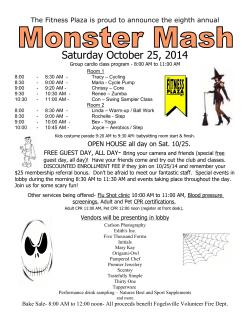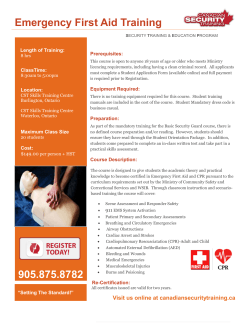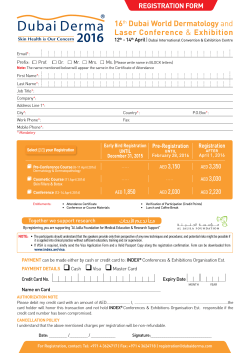
HED 334-950 - Southern Illinois University
Department of Health Education and Recreation HED 334; First Aid, CPR and AED Online Course Spring Session 2015 Professor: Dr. Peggy Wilken Office: Pulliam Hall 323 Office Hours: M, W – 1:00 to 4:00 T&R by appointment Office Phone: (618) 453-2777 Mail Box: Pulliam Hall, Room 307 E-Mail: Wilken@siu.edu Required Text: American Academy of Orthopaedic Surgeons (AAOS). First Aid, CPR and AED text; Jones and Bartlett, Sixth Edition. Prerequisites No prerequisites. Requirements Requirements for the American Academy of Orthopaedic Surgeons (AAOS): (1) Perform skills competently and demonstrate the ability to make appropriate decisions for health care (i.e., CPR, AED and First Aid) with an 80% or better accuracy. (2) Pass the written examinations in the pre-stated areas with a score of 80% or higher. (3) Certification will occur upon successful completion of the course during finals week or during the last scheduled class meeting, whichever is applicable. Course Description The purpose of the AAOS First Aid and CPR course is to provide the participants with knowledge and skills necessary to work as a “first aider” in an emergency - to help sustain life, reduce pain, and minimize the consequences of injury or sudden illness until advanced medical help arrives. 1 Course Objectives The student will be able to achieve the following cognitive objectives: 1. Read the assigned chapters in the text; 2. Increase knowledge of first aid, CPR and AED; 3. Summarize and react to current medical emergencies, CPR, AED and First Aid; 4. Complete all assignments, skills, projects, quizzes and exams. The student will be able to achieve the following affective objectives: 1. Actively participate in class discussions and activities; 2. Recognize and appreciate the diverse opinion expressed by others in the class; 3. Work cooperatively with partners on class skills. 4. Respect the diversity of various cultures, genders, orientations and races. The student will be able to accomplish the following psychomotor skills: 1. Perform with at least 80% accuracy responding to a medical emergency skills; 2. Perform with at least 80% accuracy CPR skills; 3. Perform with at least 80% accuracy AED skills; 4. Perform with at least 80% accuracy First Aid skills. Methods of Evaluation Written exams, quizzes, attendance, affective cooperatives, and psychomotor skills will be used to evaluate students. Academic Requirements Grades are determined by a point system: Quizzes (9 quizzes, 25 points each)…………………………..225 points Written Certification Exam for CPR and AED.....................100 points Attendance Points (25 points for each classroom class attended)………………………………………………………200 points Skill test for CPR and AED………………………………….150 points Skill test for First Aid and CPR………………………………50 points First Aid Kits…………………………………………………..50 points Certification Exam for First Aid……………………………100 points TOTAL POINTS……………………………………………..875 points Only Extra Credit Points……………………………………..10 points 2 Grading scale Point Scale 100-92%=A 875-805=A 91-84%= B 804-735=B 83-76%= C 734-665=C 75-68%=D 664-595=D 67% & below=F 594 & below=F Attendance will be taken at the beginning of each classroom attended class. If the student is present at the time their name is called twenty‐five points will be awarded to that student, if the student is not present at the time their name is called zero points will be awarded, no exceptions. APPROVED ABSENCES ARE ABSENCES THAT HAVE BEEN PRE‐APPROVED BY THE PROFESSOR AND MAY INCLUDE: Personal illness that is confirmed by a PHYSICIAN’S NOTE. Personal illness is inclusive of self, your child, sibling, or parent illness. Or death of an immediate family member (spouse, child, sibling, parent, or grandparent. An obituary is needed for verification. Or any other legitimate pre‐approved absence (approval at the discretion of the professor). ***Approved Absences*** that involve missed written certification exams and or skill test exams, must be made up exam within seven (7) days of the absence or zero (0) points will be awarded. ***Unapproved absences*** that involve missed written exams, quizzes, first aid kits, and/or skill tests will result in the student receiving zero (0) points. 3 First Aid Kits Acceptable first aid kits may be purchased online through the American Red Cross, www.redcross.com, Target www.target.com, Walgreens, www.walgreens.com and the kit must be registered as a 20 person first aid kit; no other first aid kit will be accepted unless approved by the instructor. FIRST AID KITS ARE DUE ON March 19, 2015 AT THE END OF THE DAY 4:30PM. First aid kits may be turned in any time before March 19, 2015. ***NO LATE KITS WILL BE ACCEPTED AFTER THE DUE DATE*** STUDENTS MAY RETAKE ANY SKILL TEST OR ANY CERTIFICATION TEST UP TO THREE TIMES. HOWEVER, AFTER THE FIRST ATTEMPT NO POINTS WILL BE ISSUED AND TESTING IS FOR CERTIFICATION PURPOSES ONLY. Extra credit points may be obtained by the following: 1) Donate blood to any approved blood bank. Signed blood donation paper work is needed as verification. 2) Or buy another first aid kit for home, automobile and/or office. 3) Or draw a schematic of your residents and show two ways out of your bedroom in case of fire at night, where you’re fire extinguishers and smoke detectors are located and where you would wait for the fire department. 4) Or any other pre‐approved medical, first aid and/or safety project. The last day that I will accept extra credit is the day of your final. When the scheduled time of your final ends, the class is over and so is the opportunity to turn in extra credit. 4 HED 334 will follow Southern Illinois University Carbondale, Department of Health Education and Recreation’s Academic Honesty Policy. Please note and read the policy that that is located on the SIUC web‐site http://web.coehs.siu.edu/public/her/AcHonPol.php Emergency Response Guide Emergency Procedures Southern Illinois University Carbondale is committed to providing a safe and healthy environment for study and work. Because some health and safety circumstances are beyond our control, we ask that you become familiar with the SIUC Emergency Response Plan and Building Emergency Response Team (BERT) program. Emergency response information is available on posters in buildings on campus, available on the BERT’s website at www.bert.siu.edu, Department of Public Safety’s website www.dps.siu.edu (disaster drop down) and in the Emergency Response Guidelines pamphlet. Know how to respond to each type of emergency. Instructors will provide guidance and direction to students in the classroom in the event of an emergency affecting your location. It is important that you follow these instructions and stay with your instructor during an evacuation or sheltering emergency. The Building Emergency Response Team will provide assistance to your instructor in evacuating the building or sheltering within the facility. Brief Safety Instructions – Pulliam Hall BERT contacts are Public Safety Officers – 453‐3771 (DPS1), Ext. 274 Radio on which emergency notifications are received is monitored by Christine Cisco. Signals: Long blast for tornado; high/low for other News available at AM 1620 and FM 91.9 Pulliam Hall Gathering Points ◊ Shelter area inside the building is the hallway on the basement level. ◊ Meeting area in case of evacuation is the northwest side of the parking lot located north of Pulliam. 5 Active Shooter If you assess it is safe to leave the building: 1) Evacuate to a safe place. 2) If you encounter others, tell them to evacuate. 3) Call 911 or if you assess it is not safe to leave the building: 1) Go to the nearest room or office. 2) Lock the door(s). If there is no lock, barricade the door. 3) If the door has a window, cover it. 4) Keep quiet, silence cell phones; act as if no one is in the room. 5) DO NOT answer the door. 6) Wait for emergency personnel. Fire 1) Evacuate with class to northwest side of parking lot; close doors ‐ but do not lock ‐ as you evacuate; DO NOT use the elevator. You will be burned to death. 2) Pull fire alarm on the way out of the building. 3) Call 911or 4) If you cannot evacuate because of fire or dense smoke, ‐ stay in the classroom, ‐ place something at base of the door to limit the smoke entering the room, ‐ open windows and signal for help. Tornado/Severe Weather 1) Move quickly to basement of Pulliam; do NOT use the elevator. 2) Keep away from windows and large open rooms such as the gymnasium or auditorium. 3) For tornado, have students sit or kneel on the floor against wall with hands on their heads. 4) Do not leave the building unless instructed. 6 Earthquake 1) If possible: ‐ hold onto heavy furniture and move with it ‐ hold onto doorway jamb, making sure swinging door cannot hit ‐ move against interior wall, kneel or sit, duck and cover. Gas Leak 1) Cease all operations, get clear of the building then call 911. 2) Do not switch lights or electrical equipment on or off (can trigger an explosion). 2) Evacuate to northwest side of parking lot. Chemical Spill 1) Immediately evacuate the building. 2) If contact with chemical: ‐ remove all contaminated clothing ‐ for eyes, rinse with water for at least 15 minutes ‐ for skin, rinse thoroughly under water, than wash with soap and water 3) Call 911. 4) Do not clean up spills. Bomb Threat 1) If notified of a bomb threat, ‐ evacuate to northwest side of parking lot. 2) If you receive a threat over the phone, ‐ keep person talking as long as possible ‐ get as much information as possible ‐ hold the line open, do not hang up ‐ using a different line, call 911 7 Police Emergency 1) If you see a crime in progress, do not attempt to apprehend or interfere, except in self‐defense. 2) If you can safely do so, note as many details as possible about the criminal (height, weight, sex, race, age, clothing, weapon if any); and vehicle (license plate number, vehicle make, model, color, direction of travel). 3) Call 911. 4) If possible, stay in the classroom until the Public Safety Officer arrives; if not possible, evacuate. Medical Emergency 1) Call 911. 2) Do not move the person unless he/she is in danger. Do not leave except to get help. 3) Render first aid/CPR if you are qualified; send a student to find either Peggy Wilken or Rusty Rice if they are in the building. 4) Let the police officers know if you have been exposed to another’s bodily fluids. Please keep this document as a reference for this course. 8
© Copyright 2025











